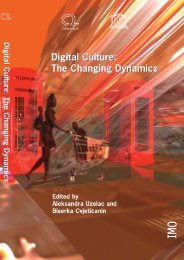free download in pdf format - Culturelink Network
free download in pdf format - Culturelink Network
free download in pdf format - Culturelink Network
You also want an ePaper? Increase the reach of your titles
YUMPU automatically turns print PDFs into web optimized ePapers that Google loves.
Cultural Identity Politics <strong>in</strong> the (Post-)Transitional Societies<br />
Conclusion<br />
In terms of cultural and national identity the relations between Austria and its south-<br />
Slavic neighbours followed a centre-periphery model, as part of a broader European<br />
<strong>in</strong>ternational division of labour <strong>in</strong> which Austria fulfi lled the role of a semi-periphery.<br />
Nation build<strong>in</strong>g, as well as the search for cultural identity, was at the beg<strong>in</strong>n<strong>in</strong>g an<br />
attempt by the respective elite, or parts of it, to l<strong>in</strong>k with the Austrian core. Austria<br />
was establish<strong>in</strong>g criteria defi n<strong>in</strong>g who belonged to “us”, who was considered worthy and<br />
able to be adopted or civilized, and who was regarded as “the other” – the opposition<br />
or enemy. Multi-ethnicity and cultural diversity went hand <strong>in</strong> hand with establish<strong>in</strong>g<br />
divisions and hierarchies along ethnic, religious and social l<strong>in</strong>es accord<strong>in</strong>g to the <strong>in</strong>terests<br />
of the core. Close ties with Vienna seemed to be helpful for identity construction. A<br />
broaden<strong>in</strong>g of national identifi cation followed later, open<strong>in</strong>g the way for a de-l<strong>in</strong>k<strong>in</strong>g of<br />
the Austrian core.<br />
In the Serbian case, identity construction was a means to overcome Ottoman rule<br />
<strong>in</strong> the 18th and 19th centuries (Konfi n, Vienna as centre of Serbian culture, Serbian<br />
state). In the Croatian case, it was to underl<strong>in</strong>e the historical Catholic, dynastic and<br />
later national ties with Vienna and, respectively, Berl<strong>in</strong> dur<strong>in</strong>g the Second World War<br />
( Jelačić, Church and Ustashi). In the Bosnian case, occupation and annexation were<br />
accepted as the price for modernization of the society. Th is model failed <strong>in</strong> all cases and<br />
provoked a reaction of de-l<strong>in</strong>k<strong>in</strong>g <strong>in</strong> cultural, political and economic terms (Pr<strong>in</strong>cip’s<br />
attack on Franz Ferd<strong>in</strong>and, K<strong>in</strong>gdom of SHS/Yugoslavia, and socialist Yugoslavia).<br />
Dur<strong>in</strong>g the dissolution of Yugoslavia <strong>in</strong> the 1990s the re<strong>in</strong>vention of national<br />
identities was a means to defi ne one’s nation’s position vis-à-vis the new order <strong>in</strong> Europe<br />
(Croatian, Slovene, Bosnian, Kosovo-Albanian elites), aga<strong>in</strong> hop<strong>in</strong>g that close ties with<br />
Vienna would help to overcome social and economic problems and stabilize the new<br />
nations. It failed aga<strong>in</strong>, lead<strong>in</strong>g the nations <strong>in</strong>to civil wars, mass kill<strong>in</strong>gs and expulsions,<br />
which legitimized foreign military <strong>in</strong>tervention that Austria could neither prevent nor<br />
stop. Austria’s role as an external reference was soon replaced by NATO, the United<br />
States and the European Union, who nowadays <strong>in</strong>tervene <strong>in</strong> the process of identity<br />
construction by discredit<strong>in</strong>g ethnic nationalism, which they had fuelled before, for not<br />
be<strong>in</strong>g compatible with “European” standards.<br />
Also on the Austrian side, the sense of be<strong>in</strong>g Balkan was a constitutive factor for identity<br />
construction. As the south-Slavic regions geopolitically formed a contested fi eld of<br />
territorial expansion, economically a hopeful territory and culturally a fi eld to modernize<br />
along the concepts of the core, the Austrian perception of the Balkan idea served as a<br />
means to strengthen Austria’s self-assertion <strong>in</strong> military, political and cultural terms. It<br />
characterized Austrianness from imperial to constitutional and democratic times, help<strong>in</strong>g<br />
to compensate for Austria’s weakness and dependency on the European West, <strong>in</strong>clud<strong>in</strong>g<br />
Nazi occupation. Th is self-assertion was built on feel<strong>in</strong>g superior to the Balkan peoples<br />
who had to face structural racism. Th ey were attributed orientaliz<strong>in</strong>g or balkaniz<strong>in</strong>g terms<br />
28



